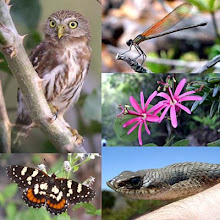I’ve blogged
a fair amount about the Pantanal in the past, and I always come home from here
with lots of material. I like to end my Mato Grosso tours here, at the very
southern end of the state, as the habitats are more open and birding is easier.
After the fast-moving mixed flocks of the Amazonian rainforests, birding dry
woodland and open marshes is a delight. Birds and animals seem much less
fearful of humans here too.
A Jabiru
feeding right next to the road is not an uncommon sight.
Buff-necked
Ibises just walk around our hotel grounds.
Hyacinth
Macaws babble fearlessly right overhead.
This Chestnut-eared
Aracari was perched quietly right by the trail one morning.
I don’t
think I’ve ever been this close to a Sungrebe. This is with my 4x
Canon PowerShot G15, as my SX50 is away for repairs and cleaning.
Plus we see Panthera onca, the Jaguar. It’s pretty
much a guaranteed thing these days – about 40 minutes up the Cuiabá River at
the end of the road in Porto Jofre, and just scan the banks along the main
river, the tributaries of the Tres Irmãos, the Piquiri, or along a few small
oxbows. With some 15-20 boats doing this, all morning and afternoon, eventually
a Jaguar gets spotted, word gets out by radio or via hand signals from passing
boatmen, and everyone converges to get views and photos of the cat.
We did not
find any Jaguars of our own; we were on the river for less than an hour our
first morning when word came of a jaguar sitting on the bank of the Piquiri.
Then not much later downstream was another. Then in the afternoon we again
didn’t have much of chance to start looking for our own Jaguar, as others had
already spotted one. Then another. Four in one day, and excellent views of all.
In the morning we saw siblings Pantaneira and Felix; I didn’t manage to get any
photos of them, though Jarmo did, and we sent them off to Paul Donahue, who
worked here for several months last summer and provided their names for me.
Each one has a unique pattern of spots on the face and can be recognized
quickly with some practice. They also have different head shapes, so they
really do look quite different.
This is
Marley, the first one in the afternoon.
And this
poor beat-up cat is Peter Schmidt.. The torn left ear is an old injury, but his
right eye, cut on his nose, and the swollen front left paw giving him a bad
limp are apparently rather recent. I digiscoped both of these animals, setting
up my Zeiss DiaScope 85 FL in front of me in the boat.
Here he came
down for a long drink before going back up to rest and recover. I had been able
to get names for all 12 of the previous Jaguars I’ve seen here since 2012, and
all four of these individuals were new for me.
We also saw
an Ocelot in the mid-afternoon crossing the Transpantaneira Highway, but it was
too quick for photos. After it disappeared in the roadside shrubbery a big
mob of birds starting making a fuss, including our only Orange-backed Troupials
of the trip.
Here are
some other fun animals we saw:
Several huge
Salvator merianae, Argentine
Black-and-white Tegus in the mid-morning sun.
Tapirus terrestris, South American Tapir
on the entrance road to Pouso Alegre, our first evening in the Pantanal.
On our last
evening we drove the same road and saw six mammals: another South American
Tapir, Brown Brocket (a small deer), Crab-eating Fox, Crab-eating Raccoon,
Nine-banded Armadillo, and Southern Tamadua (a small anteater). But my favorite
find that evening drive was this Bothrops
mattogrossensis, Mato Grosso Lancehead, stretched across the road.
Some
lists have split Bothrops into a few
smaller genera, and this one would be in Bothropoides;
more recent papers do not advocate that split though. Incidentally, I always
advise strongly that people do not use the useless name “fer-de-lance,” the
snake equivalent of “sea gull,” except that it’s French. It doesn’t apply to
any one species – there are 48 species of lanceheads in the similar genera Bothrops and Bothrocophias – and the only French speaking country with any
species at all is French Guiana, and they
don’t use the name fer-de-lance.
Finally, I
spotted this mole cricket on our last evening at Pouso Alegre. I don’t think
there are many species here, but I’ve only made as far as family with this –
Gryllotalpidae, which nicely translates as “mole cricket.”

















No comments:
Post a Comment